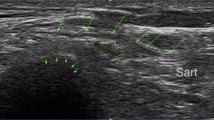Abstract
Background
In patients with persistent symptoms of meralgia paresthetica, a neurectomy of the lateral femoral cutaneous nerve (LFCN) can be performed to alleviate pain symptoms. The neurectomy procedure can be performed either as a primary procedure or after failure of a previously performed neurolysis or decompression of the LFNC (secondary neurectomy). The goal of the present study was to quantify the histopathologic changes inside the LFCN obtained from patients with persistent symptoms of meralgia paresthetica, and specifically to compare to what extend these changes are present after primary versus secondary neurectomy.
Methods
A total of 39 consecutive cases were analyzed microscopically: in 29 cases, the neurectomy had been performed as primary procedure, in 10 cases, after failed neurolysis. Intraneural changes were quantified for the (1) thickening of perineurium, (2) deposition of mucoid, and (3) percentage of collagen. Analysis was performed at three levels: proximal to, at, and distal to the previous site of compression. In addition, correlations were investigated for the duration of symptoms and the body mass index (BMI) of the patient.
Results
Intraneural changes were found consistently in all cases. There was no significant difference for the primary and secondary neurectomy groups. There was also no relation with the previous site of compression. There was a weak correlation between the occurrence of intraneural changes and the duration of symptoms, although this difference was not statistically significant.
Conclusions
Histopathological changes in this study were found in all patients with persistent symptoms of meralgia paresthetica regardless of a previously performed neurolysis procedure. This finding suggests that the intraneural changes that occur in persistent meralgia paresthetica are largely irreversible and support the surgical strategy of neurectomy as an alternative to neurolysis, also for primary surgical treatment and not only after failure of neurolysis.





Similar content being viewed by others
Notes
We are currently investigating the effectiveness of the neurolysis and neurectomy procedures in a randomized controlled trial, named the STOMP trial (Surgical Treatment Options for Meralgia Paresthetica).
References
Aszmann OC, Dellon ES, Dellon AL (1997) Anatomical course of the lateral femoral cutaneous nerve and its susceptibility to compression and injury. Plast Reconstr Surg 100:600–604
Berini SE, Spinner RJ, Jentoft ME, Engelstad JK, Staff NP, Suanprasert N, Dyck PJ, Klein CJ (2014) Chronic meralgia paresthetica and neurectomy: a clinical pathologic study. Neurology 82:1551–1555. https://doi.org/10.1212/WNL.0000000000000367
de Ruiter GC, Kloet A (2015) Comparison of effectiveness of different surgical treatments for meralgia paresthetica: results of a prospective observational study and protocol for a randomized controlled trial. Clin Neurol Neurosurg 134:7–11. https://doi.org/10.1016/j.clineuro.2015.04.007
de Ruiter GCW, Kloet F (2018) Anatomical considerations on transposition of the lateral femoral cutaneous nerve. Clin Anat. https://doi.org/10.1002/ca.23057
de Ruiter GC, Wurzer JA, Kloet A (2012) Decision making in the surgical treatment of meralgia paresthetica: neurolysis versus neurectomy. Acta Neurochir 154:1765–1772. https://doi.org/10.1007/s00701-012-1431-0
de Ruiter GC, Wurzer JA, Kloet A (2015) Recurrence of meralgia paresthetica years after a neurexeresis procedure: a case report. Br J Neurosurg 29:885–887. https://doi.org/10.3109/02688697.2015.1054358
Hanna AS (2017) Lateral femoral cutaneous nerve transposition: renaissance of an old concept in the light of new anatomy. Clin Anat 30:409–412. https://doi.org/10.1002/ca.22849
Keegan JJ, Holyoke EA (1962) Meralgia paresthetica. An anatomical and surgical study. J Neurosurg 19:341–345. https://doi.org/10.3171/jns.1962.19.4.0341
Payne R, Seaman S, Sieg E, Langan S, Harbaugh K, Rizk E (2017) Evaluating the evidence: is neurolysis or neurectomy a better treatment for meralgia paresthetica? Acta Neurochir 159:931–936. https://doi.org/10.1007/s00701-017-3136-x
Schwaiger K, Panzenbeck P, Purschke M, Russe E, Kaplan R, Heinrich K, Mandal P, Wechselberger G (2018) Surgical decompression of the lateral femoral cutaneous nerve (LFCN) for meralgia paresthetica treatment: experimental or state of the art? A single-center outcome analysis. Medicine (Baltimore) 97:e11914. https://doi.org/10.1097/MD.0000000000011914
Acknowledgements
The authors thank Maartje Kunen, medical artist, for the illustrations presented in Fig. 5.
Author information
Authors and Affiliations
Corresponding author
Ethics declarations
Conflict of interest
The authors declare that they have no conflict of interest.
Ethical approval
All procedures performed in study involving human participants were in accordance with the ethical standards of the institutional and/or national research committee (name of institute/committee) and with the 1964 Helsinki declaration and its later amendments or comparable ethical standards. No ethical approval was required for the retrospective part of the study. For the STOMP trial, ethical approval was obtained before start of the study (Dutch trial registry: NTR4530).
Additional information
Comments
This study correlates histopathological changes in the lateral femoral cutaneous nerves of patients who underwent either a primary neurolysis followed by a neurectomy due to persistence of symptoms and those who underwent a primary neurectomy. Most of the pathological changes seen in the nerves were similar in the two groups and also did not correlate with either duration of symptoms (although this can be somewhat difficult to assess as the authors point out) or BMI of the patient. These findings are important to report because they are not what one would necessarily expect or predict a priori and have important implications about treatment and further studies that need to be done.
Michel Kliot,
CA, USA
This article is part of the Topical Collection on Peripheral Nerves
Rights and permissions
About this article
Cite this article
de Ruiter, G.C.W., Lim, J., Thomassen, B.J.W. et al. Histopathologic changes inside the lateral femoral cutaneous nerve obtained from patients with persistent symptoms of meralgia paresthetica. Acta Neurochir 161, 263–269 (2019). https://doi.org/10.1007/s00701-018-3773-8
Received:
Accepted:
Published:
Issue Date:
DOI: https://doi.org/10.1007/s00701-018-3773-8




